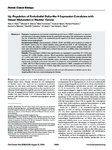Up-Regulation of Endothelial Delta-like 4 Expression Correlates with Vessel Maturation in Bladder Cancer
| dc.contributor.author | Patel, NS | |
| dc.contributor.author | Dobbie, MS | |
| dc.contributor.author | Rochester, M | |
| dc.contributor.author | Steers, G | |
| dc.contributor.author | Poulsom, R | |
| dc.contributor.author | Le Monnier, K | |
| dc.contributor.author | Cranston, DW | |
| dc.contributor.author | Li, J-L | |
| dc.contributor.author | Harris, AL | |
| dc.date.accessioned | 2017-11-27T16:26:11Z | |
| dc.date.available | 2017-11-27T16:26:11Z | |
| dc.date.issued | 2006-08-15 | |
| dc.identifier.issn | 1078-0432 | |
| dc.identifier.issn | 1557-3265 | |
| dc.identifier.uri | http://hdl.handle.net/10026.1/10305 | |
| dc.description.abstract |
<jats:title>Abstract</jats:title> <jats:p>Purpose: Angiogenesis and vascular endothelial growth factor (VEGF) expression are associated with a poor outcome in bladder cancer. To understand more about the mechanisms, we studied the role of delta-like 4 (DLL4), an endothelial-specific ligand of the Notch signaling pathway, in bladder cancer angiogenesis.</jats:p> <jats:p>Experimental Design: The expression of DLL4, CD34, and VEGF were studied in a cohort of 60 bladder tumors and 10 normal samples using quantitative PCR. In situ hybridization was used to study the pattern of DLL4 expression in 22 tumor and 9 normal samples. Serial sections were also stained for CD34 and α-smooth muscle actin (α-SMA) using conventional immunohistochemistry.</jats:p> <jats:p>Results: The expression of DLL4 was significantly up-regulated in superficial (P &lt; 0.01) and invasive (P &lt; 0.05) bladder cancers. DLL4 expression significantly correlated with CD34 (P &lt; 0.001) and VEGF (P &lt; 0.001) expression. The in situ hybridization studies showed that DLL4 was highly expressed within bladder tumor vasculature. Additionally, DLL4 expression significantly correlated with vessel maturation as judged by periendothelial cell expression of α-SMA, 98.7% of DLL4-positive tumor vessels coexpressed α-SMA, compared with 64.5% of DLL4-negative tumor vessels (P &lt; 0.001). High DLL4 expression may have prognostic value in superficial and invasive bladder.</jats:p> <jats:p>Conclusion: DLL4 expression is associated with vascular differentiation in bladder cancer; thus, targeting DLL4 may be a novel antiangiogenic therapy.</jats:p> | |
| dc.format.extent | 4836-4844 | |
| dc.format.medium | ||
| dc.language | en | |
| dc.language.iso | eng | |
| dc.publisher | American Association for Cancer Research (AACR) | |
| dc.subject | Actins | |
| dc.subject | Adaptor Proteins, Signal Transducing | |
| dc.subject | Adult | |
| dc.subject | Aged | |
| dc.subject | Aged, 80 and over | |
| dc.subject | Antigens, CD34 | |
| dc.subject | Calcium-Binding Proteins | |
| dc.subject | Carcinoma, Transitional Cell | |
| dc.subject | Cohort Studies | |
| dc.subject | Female | |
| dc.subject | Humans | |
| dc.subject | Immunohistochemistry | |
| dc.subject | Intercellular Signaling Peptides and Proteins | |
| dc.subject | Male | |
| dc.subject | Middle Aged | |
| dc.subject | Neovascularization, Pathologic | |
| dc.subject | Polymerase Chain Reaction | |
| dc.subject | Prognosis | |
| dc.subject | Up-Regulation | |
| dc.subject | Urinary Bladder Neoplasms | |
| dc.subject | Vascular Endothelial Growth Factor A | |
| dc.title | Up-Regulation of Endothelial Delta-like 4 Expression Correlates with Vessel Maturation in Bladder Cancer | |
| dc.type | journal-article | |
| dc.type | Article | |
| plymouth.author-url | https://www.ncbi.nlm.nih.gov/pubmed/16914569 | |
| plymouth.issue | 16 | |
| plymouth.volume | 12 | |
| plymouth.publication-status | Published | |
| plymouth.journal | Clinical Cancer Research | |
| dc.identifier.doi | 10.1158/1078-0432.ccr-06-0285 | |
| plymouth.organisational-group | /Plymouth | |
| plymouth.organisational-group | /Plymouth/REF 2021 Researchers by UoA | |
| plymouth.organisational-group | /Plymouth/REF 2021 Researchers by UoA/UoA01 Clinical Medicine | |
| plymouth.organisational-group | /Plymouth/REF 2021 Researchers by UoA/UoA01 Clinical Medicine/UoA01 Clinical Medicine | |
| dc.publisher.place | United States | |
| dc.identifier.eissn | 1557-3265 | |
| dc.rights.embargoperiod | Not known | |
| rioxxterms.versionofrecord | 10.1158/1078-0432.ccr-06-0285 | |
| rioxxterms.licenseref.uri | http://www.rioxx.net/licenses/all-rights-reserved | |
| rioxxterms.type | Journal Article/Review |


